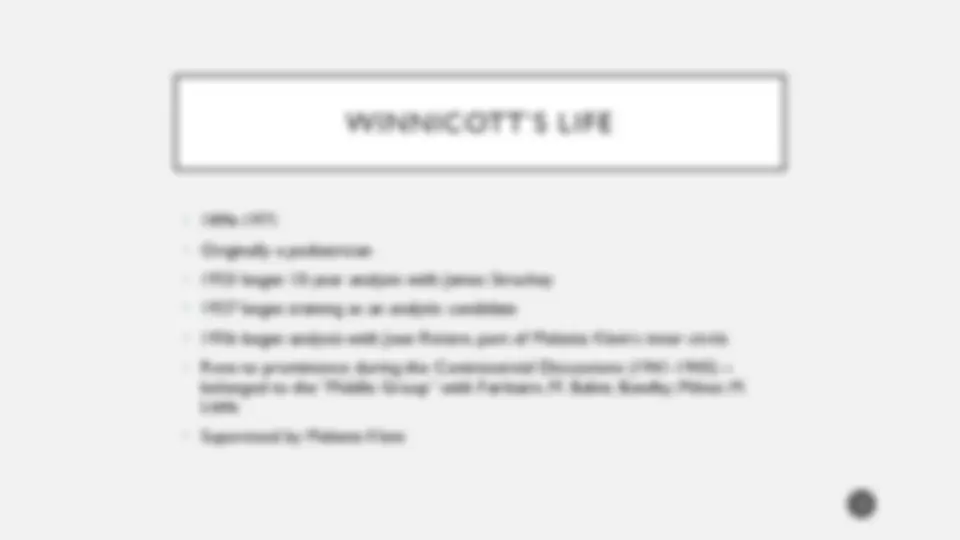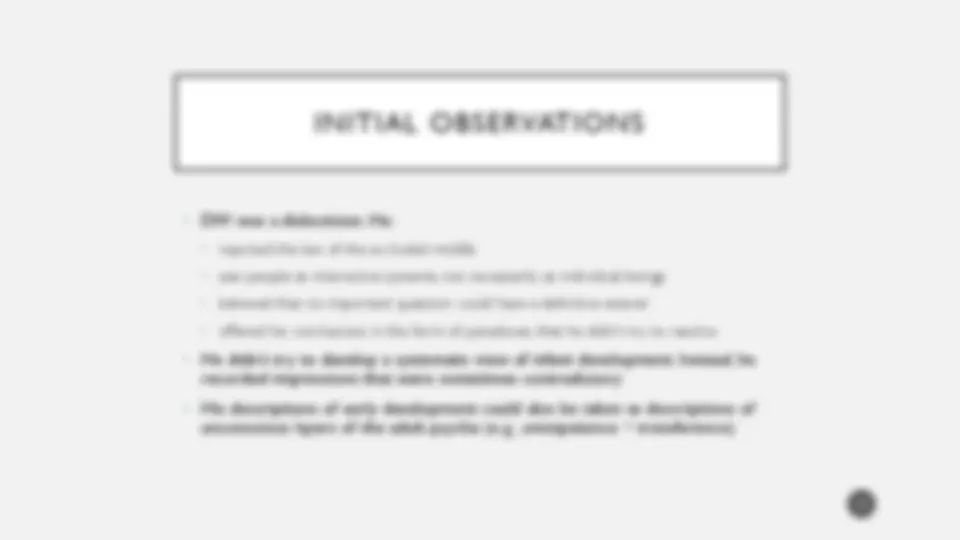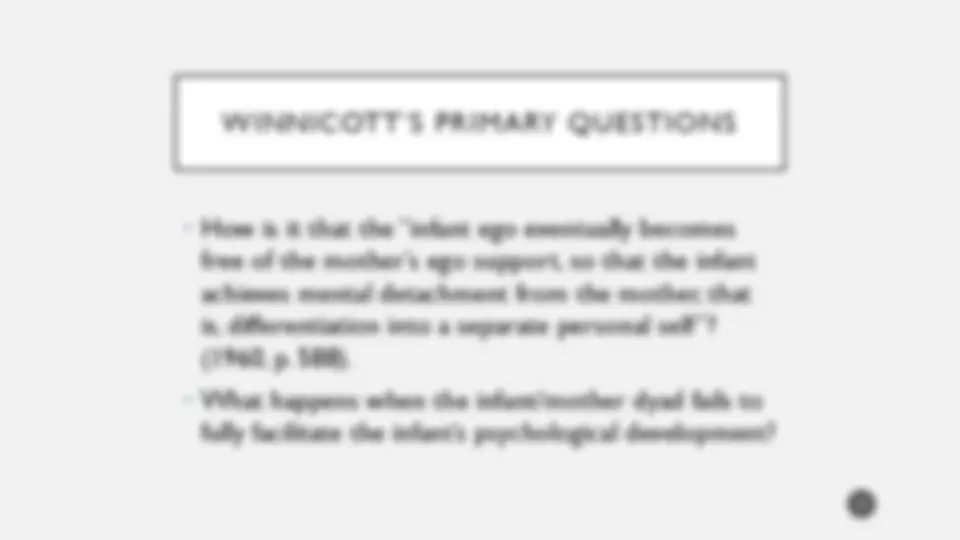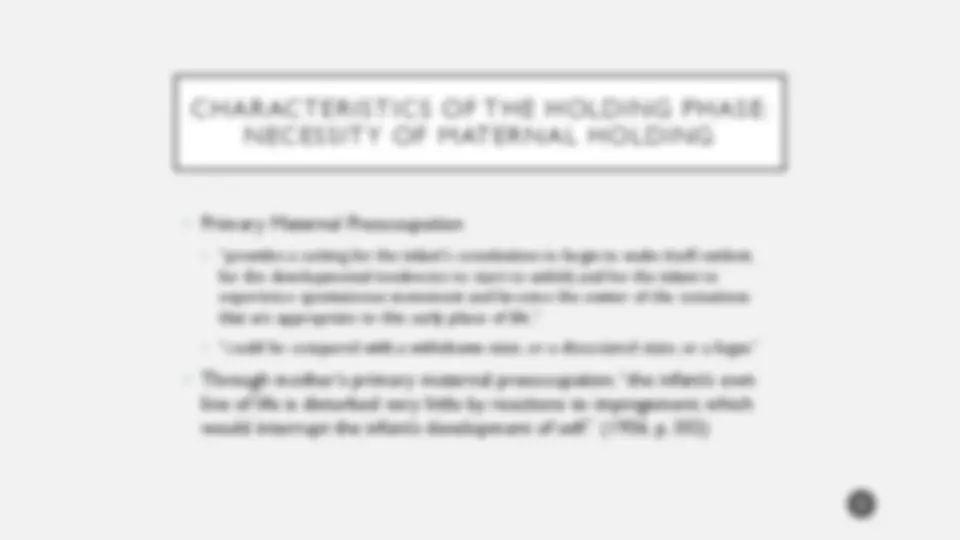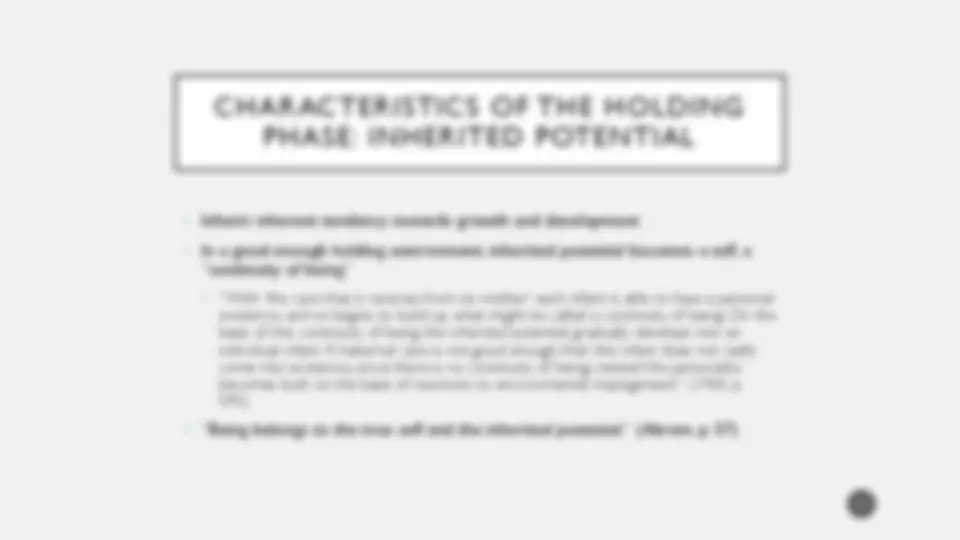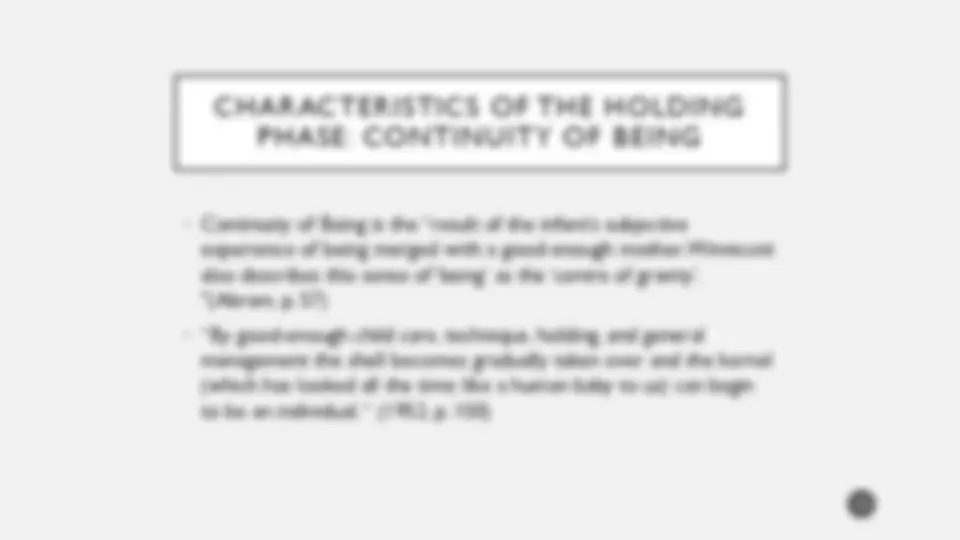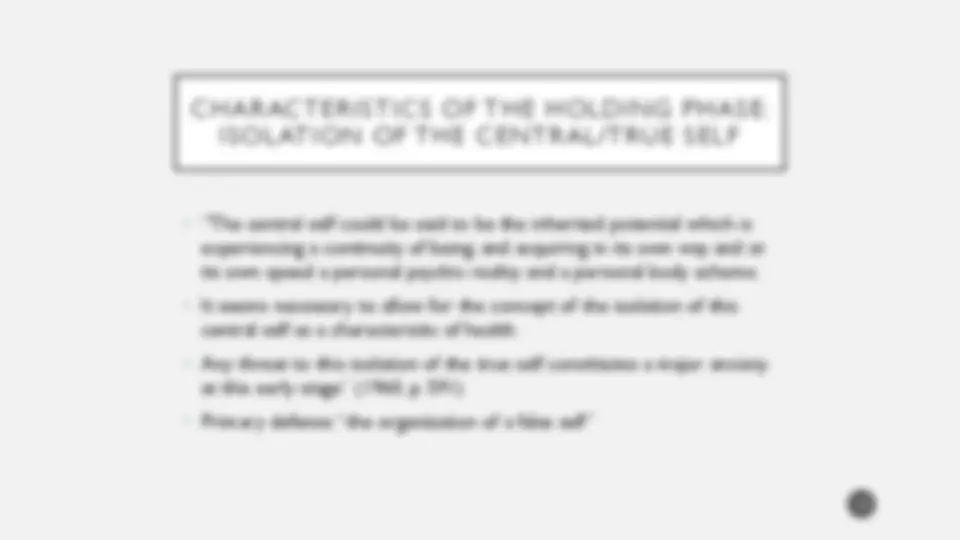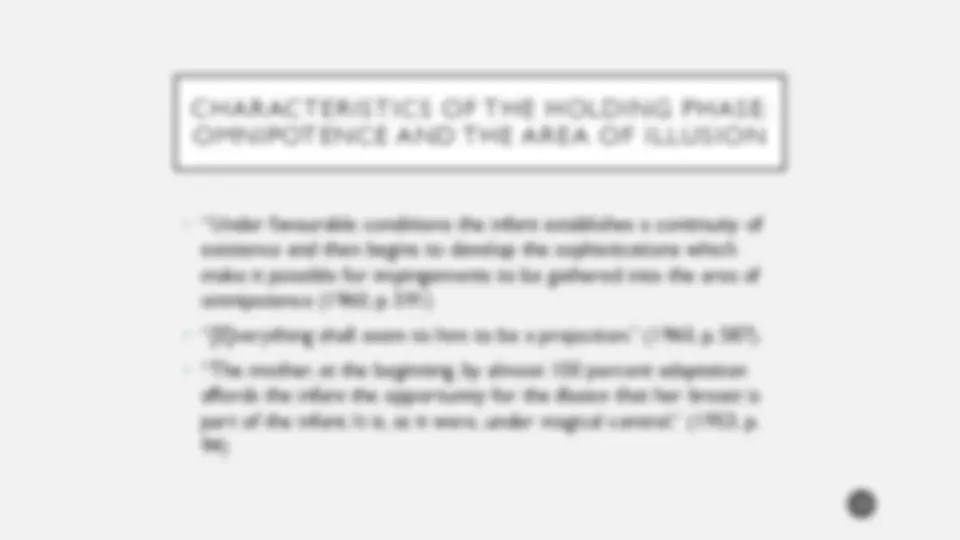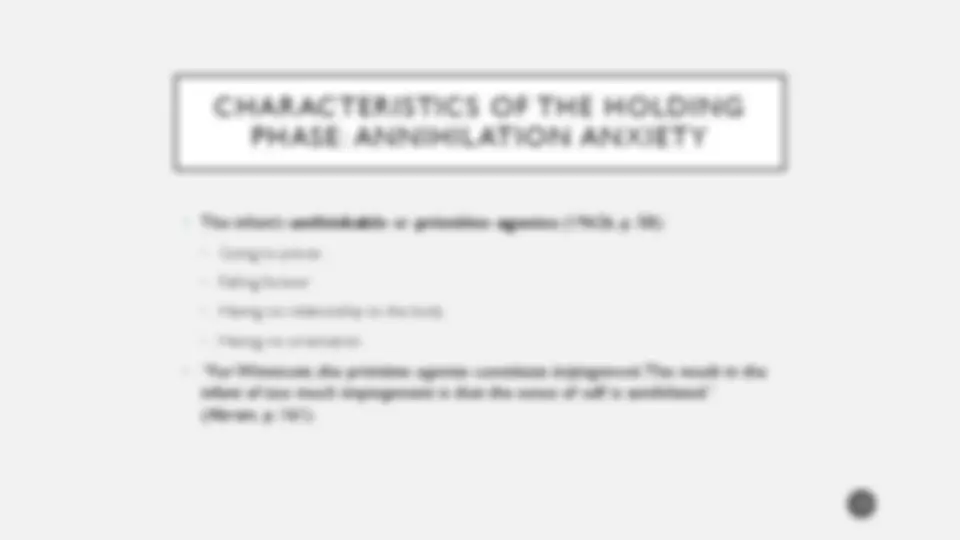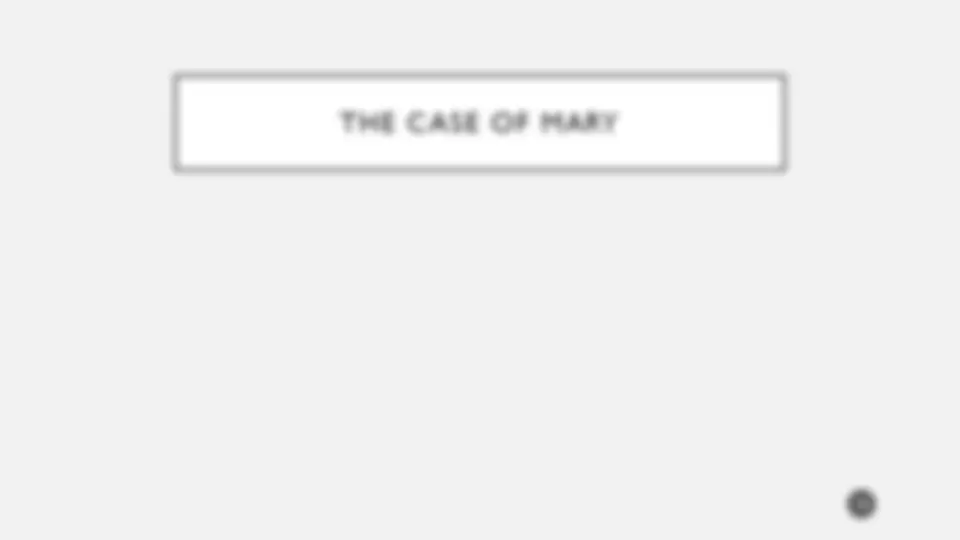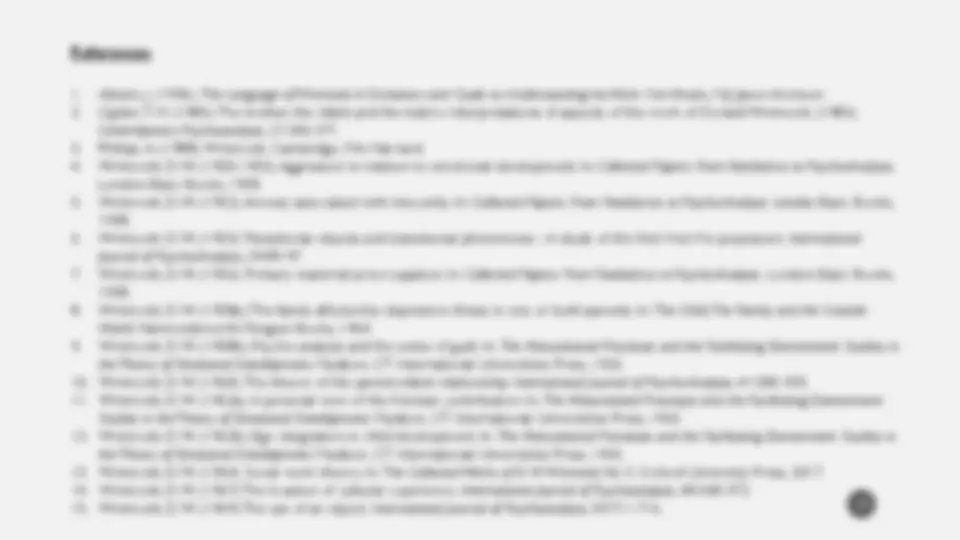Download Winnicott Theory of Parents Infant Relationship and more Papers Psychology in PDF only on Docsity!
WINNICOTT’S THEORY OF THE
PARENT-INFANT RELATIONSHIP
SEMINA R O N D. W. W INNICOT T ’S PA P ER S
I N T E R N AT I O N A L P S Y C H OT H E R A P Y I N S T I T U T E – S A LT L A K E C I T Y
November 4, 2021
Jim Poulton, Ph.D.
jlpoulton@mac.com
OVERVIEW
- Who was Donald Winnicott?
- Winnicott’s Primary Questions
- Overview of the three papers we’ll discuss in this series
- Primary characteristics of the holding phase
- Clinical considerations and the case of Mary
INITIAL OBSERVATIONS
- DW was a dialectician. He:
- rejected the law of the excluded middle
- saw people as interactive systems, not necessarily as individual beings
- believed that no important question could have a definitive answer
- offered his conclusions in the form of paradoxes that he didn’t try to resolve
- He didn’t try to develop a systematic view of infant development. Instead, he recorded impressions that were sometimes contradictory
- His descriptions of early development could also be taken as descriptions of unconscious layers of the adult psyche (e.g., omnipotence = transference)
WINNICOTT’S PRIMARY QUESTIONS
- How is it that the “infant ego eventually becomes free of the mother’s ego support, so that the infant achieves mental detachment from the mother, that is, differentiation into a separate personal self”? (1960, p. 588).
- What happens when the infant/mother dyad fails to fully facilitate the infant’s psychological development?
THE HOLDING PHASE: EARLY FUSION BETWEEN MOTHER AND INFANT
- ““[A]t the earliest stages the infant and the maternal care belong to each other and cannot be disentangled. … There is no such thing as an infant” (1960, p. 587)
- Altered the traditional (Kleinian and Freudian) view of the individual as an isolated entity
- Infant development was now conceptualized in unfamiliar terms: dialectical, paradoxical, nonlinear (i.e., no direct causal arrow), circular, and conglomerated (fusion of self and other)
CHARACTERISTICS OF THE HOLDING PHASE: NECESSITY OF MATERNAL HOLDING
- Primary Maternal Preoccupation
- “provides a setting for the infant's constitution to begin to make itself evident, for the developmental tendencies to start to unfold, and for the infant to experience spontaneous movement and become the owner of the sensations that are appropriate to this early phase of life.”
- “could be compared with a withdrawn state, or a dissociated state, or a fugue”
- Through mother’s primary maternal preoccupation, “the infant’s own
line of life is disturbed very little by reactions to impingement, which
would interrupt the infant’s development of self.” (1956, p. 302)
CHARACTERISTICS OF THE HOLDING PHASE: CONTINUITY OF BEING
- Continuity of Being is the “result of the infant’s subjective experience of being merged with a good-enough mother. Winnicott also describes this sense of ‘being’ as the ‘centre of gravity’. "(Abram, p. 57)
- “By good-enough child care, technique, holding, and general management the shell becomes gradually taken over and the kernel (which has looked all the time like a human baby to us) can begin to be an individual. “ (1952, p. 100)
CHARACTERISTICS OF THE HOLDING PHASE: INFANT’S PRIMARY CREATIVITY
- The infant’s creativity is “primary, pre-sexual, and characterizes the naturally reciprocal relationship of a baby with his ‘ordinary devoted mother.’” (Phillips, p. 102)
- It represents the primitive love impulse fused with aggression
- “In this era there is not even ruthlessness; it is a pre-ruth era, and if destruction be part of the aim in the id impulse, then destruction is only incidental to id satisfaction.” (1950-55, p. 210)
- Aggression is part of the infant’s natural appetite; it is “purpose without concern” and “destructive by chance” (1950-55, p, 206, 211)
CHARACTERISTICS OF THE HOLDING PHASE: ISOLATION OF THE CENTRAL/TRUE SELF
- “The central self could be said to be the inherited potential which is
experiencing a continuity of being, and acquiring in its own way and at
its own speed a personal psychic reality and a personal body scheme.
- It seems necessary to allow for the concept of the isolation of this
central self as a characteristic of health.
- Any threat to this isolation of the true self constitutes a major anxiety
at this early stage” (1960, p. 591)
- Primary defense: “the organization of a false self”
CHARACTERISTICS OF THE HOLDING PHASE: OMNIPOTENCE AND THE AREA OF ILLUSION
- “Under favourable conditions the infant establishes a continuity of existence and then begins to develop the sophistications which make it possible for impingements to be gathered into the area of omnipotence (1960, p. 591)
- “[E]verything shall seem to him to be a projection.” (1960, p. 587).
- “The mother, at the beginning, by almost 100 percent adaptation affords the infant the opportunity for the illusion that her breast is part of the infant. It is, as it were, under magical control.” (1953, p.
GROWTH REQUIRES DISILLUSIONMENT AND A GRADUAL LETTING-GO
- In a holding environment provided by a good-enough mother, the infant is able to transition:
- From omnipotence to the acceptance of limitations
- From pleasure principle to the reality principle
- From illusion to disillusionment
- From the “subjective object subjectively perceived” to the “objective object”
- From primary maternal preoccupation (and mother’s “magical understanding of [the infant’s] need”) to separateness (1960, p. 593)
WORKING WITH PATIENTS WHO EXPERIENCED RUPTURES IN THE HOLDING PHASE
- Waiting for the emergence of going-on being and the integrated self. People, can’t be forced to develop, but they will do so spontaneously in an unintrusive setting: “As a psychoanalyst, I have had very good training in this matter of waiting and waiting and waiting.” (1964, p. 372)
- Importance of the reliability of the therapist : “[I]f the patient did not experience reliability in the maternal care of infancy, he will need to find it for the first time in the analyst’s behaviour.” (1960, p. 586)
- On the capacity to use the object (the therapist) : “[I]nterpreting by the analyst, if it is to have effect, must be related to the patient's ability to place the analyst outside the area of subjective phenomena.” (1969, p. 711)
References
- Abram, J. (1996). The Language of Winnicott: A Dictionary and Guide to Understanding his Work. Northvale, NJ: Jason Aronson.
- Ogden, T. H. (1985). The mother, the infant and the matrix: Interpretations of aspects of the work of Donald Winnicott. (1985). Contemporary Psychoanalysis , 21 :346-371.
- Phillips, A. (1988). Winnicott. Cambridge, MA: Harvard.
- Winnicott, D. W. (1950-1955). Aggression in relation to emotional development. In: Collected Papers: From Paediatrics to Psycho-Analysis. London: Basic Books, 1958.
- Winnicott, D. W. (1952). Anxiety associated with insecurity. In: Collected Papers: From Paediatrics to Psycho-Analysis. London : Basic Books,
- Winnicott. D. W. (1953). Transitional objects and transitional phenomena – A study of the first Not-Me possession. International Journal of Psycho-Analysis , 34 :89-97.
- Winnicott, D. W. (1956). Primary maternal preoccupation. In: Collected Papers: From Paediatrics to Psycho-Analysis. London: Basic Books,
- Winnicott, D. W. (1958a). The family affected by depressive illness in one or both parents. In: The Child,The Family, and the Outside World. Harmondsworth: Penguin Books, 1964.
- Winnicott, D. W. (1958b). Psycho-analysis and the sense of guilt. In: The Maturational Processes and the Facilitating Environment: Studies in the Theory of Emotional Development. Madison, CT: International Universities Press, 1965.
- Winnicott, D. W. (1960). The theory of the parent-infant relationship. International Journal of Psycho-Analysis , 41 :585-595.
- Winnicott, D. W. (1962a). A personal view of the Kleinian contribution. In: The Maturational Processes and the Facilitating Environment: Studies in the Theory of Emotional Development. Madison, CT: International Universities Press, 1965.
- Winnicott, D. W. (1962b). Ego integration in child development. In: The Maturational Processes and the Facilitating Environment: Studies in the Theory of Emotional Development. Madison, CT: International Universities Press, 1965.
- Winnicott, D. W. (1964). Social work theory. In: The Collected Works of D.W.Winnicott,Vol. 5. Oxford University Press, 2017.
- Winnicott, D. W. (1967) The location of cultural cxperience. International Journal of Psychoanalysis , 48 :368-372.
- Winnicott, D. W. (1969) The use of an object. International Journal of Psychoanalysis , 50 :711-716. 19

